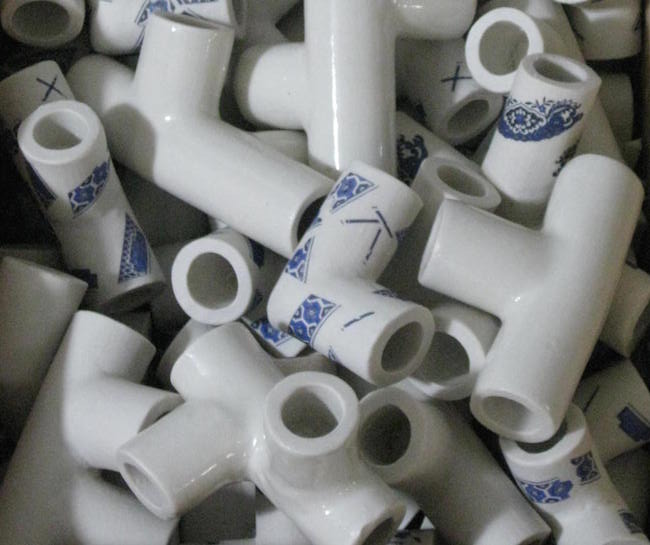Porcelain can enhance even the most functional of objects and we can’t think of an object as purely function as scaffolding joints.
In 2011 two designers, independent of one another, adapted porcelain for use as scaffolding joints in architecture and furniture. In the case of the architectural function, the joints take an opportunity for artfulness that had not been utilized yet, in spite of all the scaffolds that crawl up the sides of buildings in cities across the planet. Functional should be pleasing to the eye as well.


Scaffolding Brut by Eyal Burstein.
The architectural joints were designed by Berlin studio Beta Tank, which now appears to be known as Studio Eyal Burstein. According to Dezeen, Burstein’s Scaffolding Brut project was presented in the Victoria & Albert museum as part of the London Design Festival. Burstein states of the project:
Beta Tank has been fascinated by scaffolding for a few years. Although these structures are found on almost every street, their aesthetic form comes from a system of safety requirements and repetitive engineering configurations, rather than any artistic endeavour. The fact that such a visual construction universally exists untouched by design is an extremely interesting phenomenon that is inspirational.
Beta Tank is primarily interested in the following questions, “If scaffolding systems are so impressive without design specifications, how utterly magnificent could they become if the need for beauty was attributed to construction?” And, “given the fact that they cover large sections of any given city, rather than getting in the way, could scaffolding assist accessibility and mobility?”
The joints are glazed and are set with platinum nuts and bolts.
The other set, Underconstruction, is by London designer Ornella Stocco. Designed for the home, the joints use more decorative elements than Burstein’s (still mostly utilitarian) scaffolding joints.
Stocco states of the project:
Underconstruction consists of porcelain elbows that connect wood sticks to assemble furniture. I wanted to push forward the boundaries of porcelain’s common values by playing with its symbol of fragility and delicacy, and give a new use to it. On one hand, the porcelain elbows function as hardware fittings giving freedom to the user to customise his/her own piece of furniture. On the other, they create a familiar and warm domestic construction.
Underconstruction combines wood and porcelain within a functional structure by looking for the most suitable form and state of porcelain in order to make it utile. For that reason, the elbows have been high fired and therefore vitrified so they reach their most resistant strength level. The blue willows transfers immediately explain the material it’s made of.
As a first prototype, the porcelain elbows brings together a multifunctional piece of furniture consisting of a table and two coat racks for home interior or retail display. The idea is having a flat-packed product that can be easily assembled together.


Underconstruction by Ornella Stocco.
Seeing these together reminds us of an installation Chinese artist Ai Weiwei created for Art Basel. It’s a strange piece of synchonicity that many artists and designers are looking to common scaffolding as a resource for expression. Field is Weiwei’s 2010 work.

Ai Weiwei, Field, 2010. Courtesy of the artist and Galerie Urs Meile, Beijing,-Luzern
Any thoughts about this post? Share yours in the comment box below.



Underconstruction by Ornella Stocco.

Add your valued opinion to this post.